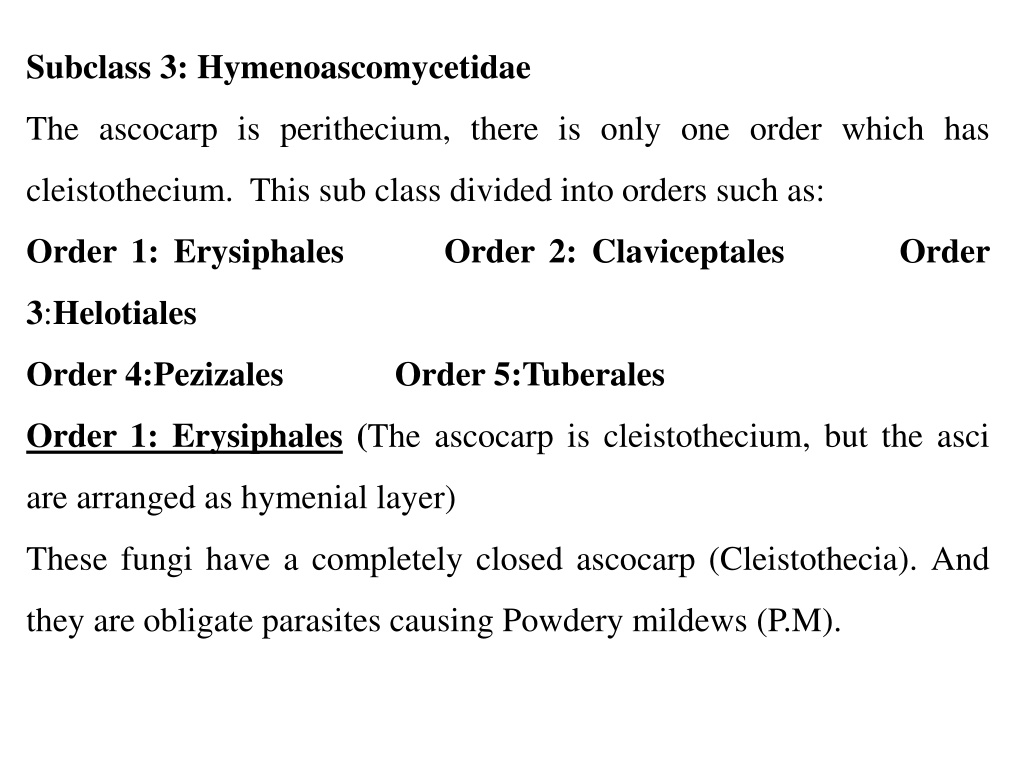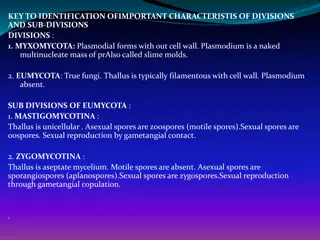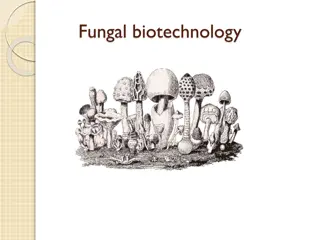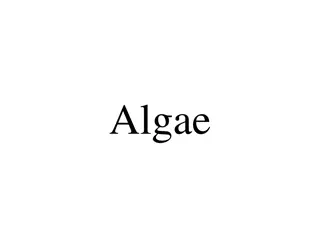Fungal Classification and Reproduction in Hymenoascomycetidae Subclass
Hymenoascomycetidae subclass includes orders like Erysiphales, Claviceptales, Helotiales, Pezizales, and Tuberales. Erysiphales fungi cause Powdery Mildews with closed ascocarps, while Claviceptales produce filamentous ascospores. Asexual reproduction involves conidiophores, while sexual reproduction forms ascocarps. Various genera like Sphaerotheca and Claviceps are discussed, each causing specific plant diseases. The life cycle of Claviceps purpurea, causing Ergot of Rye, is detailed.
Download Presentation

Please find below an Image/Link to download the presentation.
The content on the website is provided AS IS for your information and personal use only. It may not be sold, licensed, or shared on other websites without obtaining consent from the author. Download presentation by click this link. If you encounter any issues during the download, it is possible that the publisher has removed the file from their server.
E N D
Presentation Transcript
Subclass 3: Hymenoascomycetidae The ascocarp is perithecium, there is only one order which has cleistothecium. This sub class divided into orders such as: Order 1: Erysiphales Order 2: Claviceptales Order 3:Helotiales Order 4:Pezizales Order 5:Tuberales Order 1: Erysiphales (The ascocarp is cleistothecium, but the asci are arranged as hymenial layer) These fungi have a completely closed ascocarp (Cleistothecia). And they are obligate parasites causing Powdery mildews (P.M).
Asexual Reproduction: a few days after the fungus has infected the host, its somatic hyphae produce great numbers of long, hyaline, erect conidiophores. A generative cell at the apex of each conidiophore now begins producing conidia. Sexual Reproduction: sexual reproduction occurs by antheridium and ascogonium. The result of sexual reproduction is forming the ascocarps which appear white in color at the first time then converted to orange or red. The classification of family Erysiphaceaedepends on the number of asci inside the ascocarp and the type of appendages as follows:
Genus 1:Sphaerotheca: There is only one ascus in ascocarp appendages. - Causes P. M. on Rose Genus 2:Erysiphe: Ther are many asci in ascocarp. The appendages are similar to the hyphae, (mycelioid appendages). Causes P.M. on Graminae. Genus 3: Podosphaera: One ascus. - Dichotomously branched appendages tips. Causes P.M. on Apple. Genus 4:Phyllactinia Many asci. - Bulbous appendages bases. - Cause P.M. on Morus. - Mycelioid
Genus 5:Uncinulla: Many asci. - Hook-shaped appendages. - Causes P.M. on Grap. Genus 6:Microsphaera: Many asci. - Dichotomously branched appendages tips - Causes P.M. on Lilac. Order 2: Claviceptales (The ascocarp is perithecium type, and the ascospores are filamentous form) The Claviceptales produce their perithecia with a well- developed, stroma composed entirely of fungal tissue. Family: Claviceptaceae Genus1: Claviceps purpurea
The Life cycle of Claviceps purpurea:- , the cause of ergot of Rye, will be used as an example of family Claviceptaceae. The thread- like ascospores are discharged from the perithecia in the spring about the time that certain susceptible grasses such as rye are in bloom. If the ascospores, which are wind disseminated, happen to reach the flowers of the rye plant or other susceptible host, they germinate, send germ tubes into ovary, and cause infection. As the mycelium developed, it destroys the ovary tissues and replaces them in the flower by a soft, white, cottony, mycelial mat that soon becomes covered by Acervulus- like layers of short conidiophores bearing minute, oval conidia at their tips.
These conidia are mixed with a sticky, sweet, nectar-like secretion, the origin of which is obscure. Attracted by this nectar, insects visit the infected ovaries and distribute the conidia to uninfected flowers, spreading the fungus in this way. In the meantime, the mycelium mat, which has produced the conidiophores, continues to develop, and eventually transformed into a hard pink or purplish pseudoparenchymatous sclerotium. During the harvesting operations, many sclerotia are knocked off the spikletes, and fall to the ground where they pass the winter. The following spring, the sclerotia germinate and form several long-stalked, mushroom-like, dark purple stromata with globose head. The stromata, which are about three-eights of an inch tall, are easily visible .
Within these stromatal heads and just below their surfaces, arise a number of minute cavities surrounded by the pseudoparenchymatous stromatic tissue. Each cavity contains a single, multinucleate Ascogonium at the base of which one or more multinucleate antheridia form. Plasmogamy takes place between one of the antheridia and the Ascogonium, with the male nuclei migrating into female organ .
While the asci are forming, thin perithecial walls develop around these sexual apparatus within the stromatal heads, producing definite perithecia that open out on the surface of the stroma through a long-neck-like ostiole . Each mature perithecium bears several elongated, cylindrical asci, each containing eight thread- like ascospores. The sclerotia contain a number of poisoning alkaloids are responsible for poisoning animals, including humans. Cattle are often poisoned by grazing on grasses that carry the sclerotia of the fungus or in fields where the sclerotia are lying, having fallen off the plants during harvesting operations.























